University Employment Relations Essay: Trade Unions' Relevance Today
VerifiedAdded on 2020/04/15
|10
|2780
|251
Essay
AI Summary
This essay critically examines the relevance of trade unions in contemporary employment relations, specifically within the UK context. It begins with an introduction to trade unions and their historical significance in protecting employee rights and negotiating working conditions. The essay then assesses the current state of trade unionism, considering factors such as declining membership, changes in the economy, and shifts in employer practices. It explores the impact of globalization, flexible working arrangements, and the gig economy on union influence. The analysis includes a comparison with the period of 'union power' in the 1970s, evaluating the transformations that occurred from 1979 onwards, including the impact of government policies. Finally, the essay assesses different trade union strategies for meeting current challenges and potential revitalization, such as utilizing social media, membership campaigns, and addressing issues like Brexit and automation. The conclusion provides an overall judgment on the continued relevance of trade unions in the modern workplace.
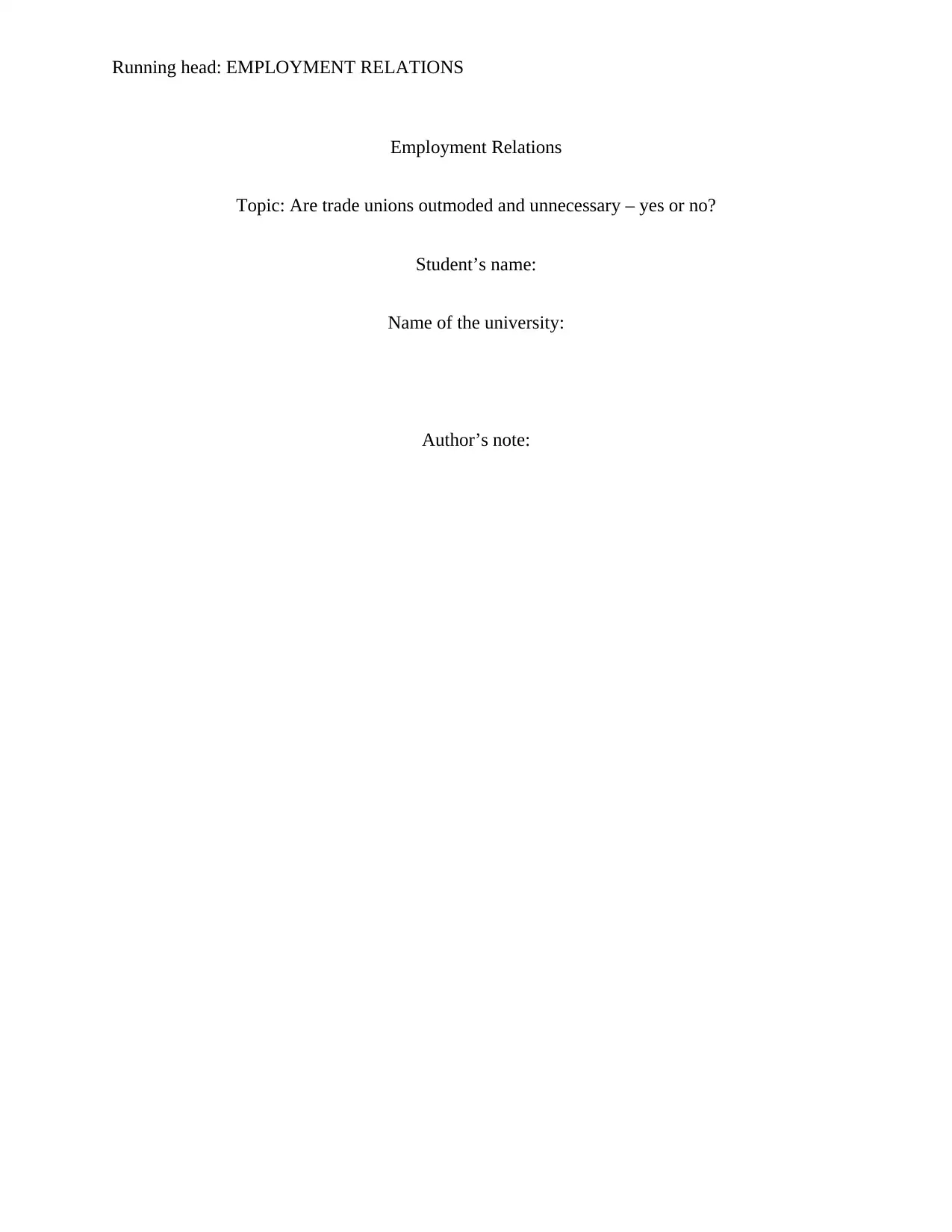
Running head: EMPLOYMENT RELATIONS
Employment Relations
Topic: Are trade unions outmoded and unnecessary – yes or no?
Student’s name:
Name of the university:
Author’s note:
Employment Relations
Topic: Are trade unions outmoded and unnecessary – yes or no?
Student’s name:
Name of the university:
Author’s note:
Paraphrase This Document
Need a fresh take? Get an instant paraphrase of this document with our AI Paraphraser
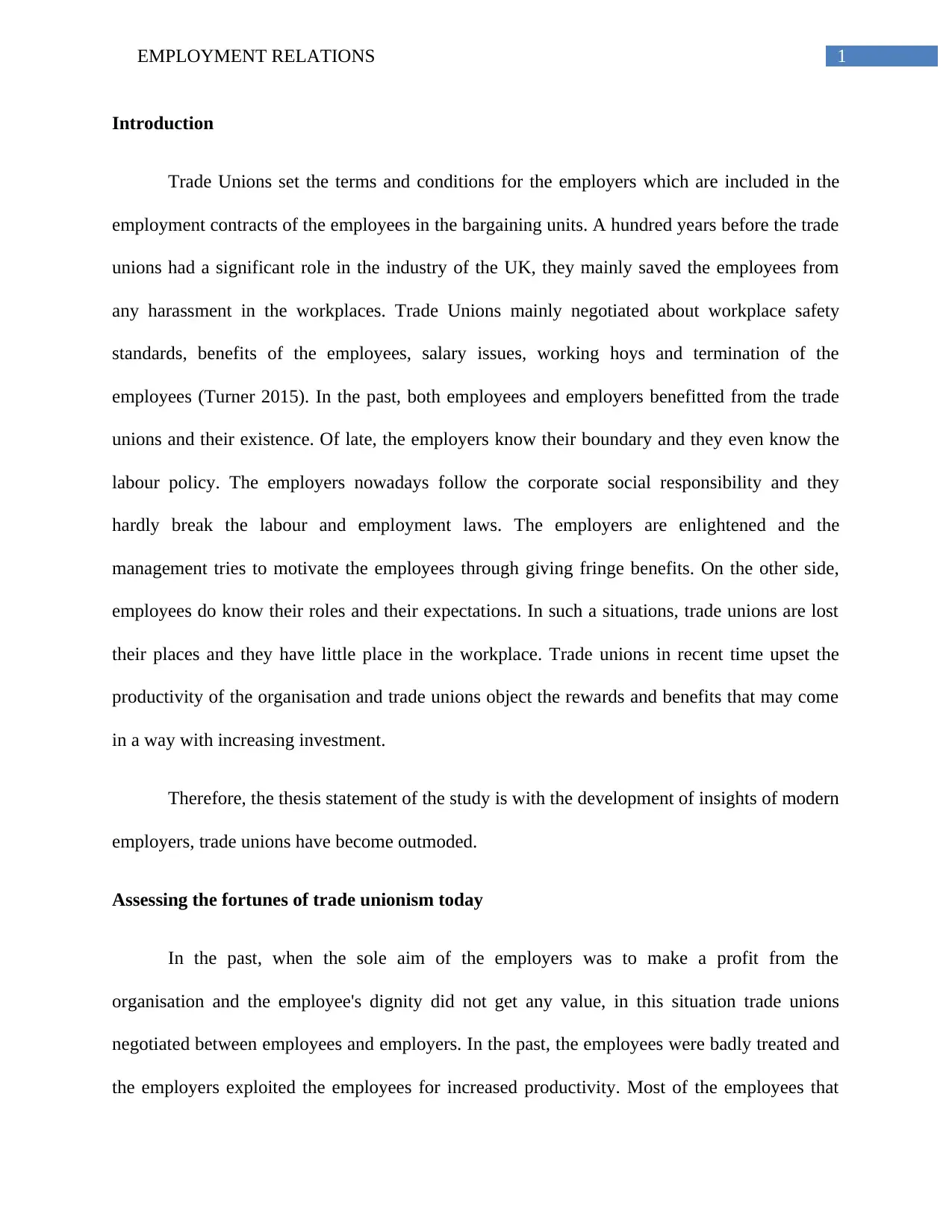
1EMPLOYMENT RELATIONS
Introduction
Trade Unions set the terms and conditions for the employers which are included in the
employment contracts of the employees in the bargaining units. A hundred years before the trade
unions had a significant role in the industry of the UK, they mainly saved the employees from
any harassment in the workplaces. Trade Unions mainly negotiated about workplace safety
standards, benefits of the employees, salary issues, working hoys and termination of the
employees (Turner 2015). In the past, both employees and employers benefitted from the trade
unions and their existence. Of late, the employers know their boundary and they even know the
labour policy. The employers nowadays follow the corporate social responsibility and they
hardly break the labour and employment laws. The employers are enlightened and the
management tries to motivate the employees through giving fringe benefits. On the other side,
employees do know their roles and their expectations. In such a situations, trade unions are lost
their places and they have little place in the workplace. Trade unions in recent time upset the
productivity of the organisation and trade unions object the rewards and benefits that may come
in a way with increasing investment.
Therefore, the thesis statement of the study is with the development of insights of modern
employers, trade unions have become outmoded.
Assessing the fortunes of trade unionism today
In the past, when the sole aim of the employers was to make a profit from the
organisation and the employee's dignity did not get any value, in this situation trade unions
negotiated between employees and employers. In the past, the employees were badly treated and
the employers exploited the employees for increased productivity. Most of the employees that
Introduction
Trade Unions set the terms and conditions for the employers which are included in the
employment contracts of the employees in the bargaining units. A hundred years before the trade
unions had a significant role in the industry of the UK, they mainly saved the employees from
any harassment in the workplaces. Trade Unions mainly negotiated about workplace safety
standards, benefits of the employees, salary issues, working hoys and termination of the
employees (Turner 2015). In the past, both employees and employers benefitted from the trade
unions and their existence. Of late, the employers know their boundary and they even know the
labour policy. The employers nowadays follow the corporate social responsibility and they
hardly break the labour and employment laws. The employers are enlightened and the
management tries to motivate the employees through giving fringe benefits. On the other side,
employees do know their roles and their expectations. In such a situations, trade unions are lost
their places and they have little place in the workplace. Trade unions in recent time upset the
productivity of the organisation and trade unions object the rewards and benefits that may come
in a way with increasing investment.
Therefore, the thesis statement of the study is with the development of insights of modern
employers, trade unions have become outmoded.
Assessing the fortunes of trade unionism today
In the past, when the sole aim of the employers was to make a profit from the
organisation and the employee's dignity did not get any value, in this situation trade unions
negotiated between employees and employers. In the past, the employees were badly treated and
the employers exploited the employees for increased productivity. Most of the employees that
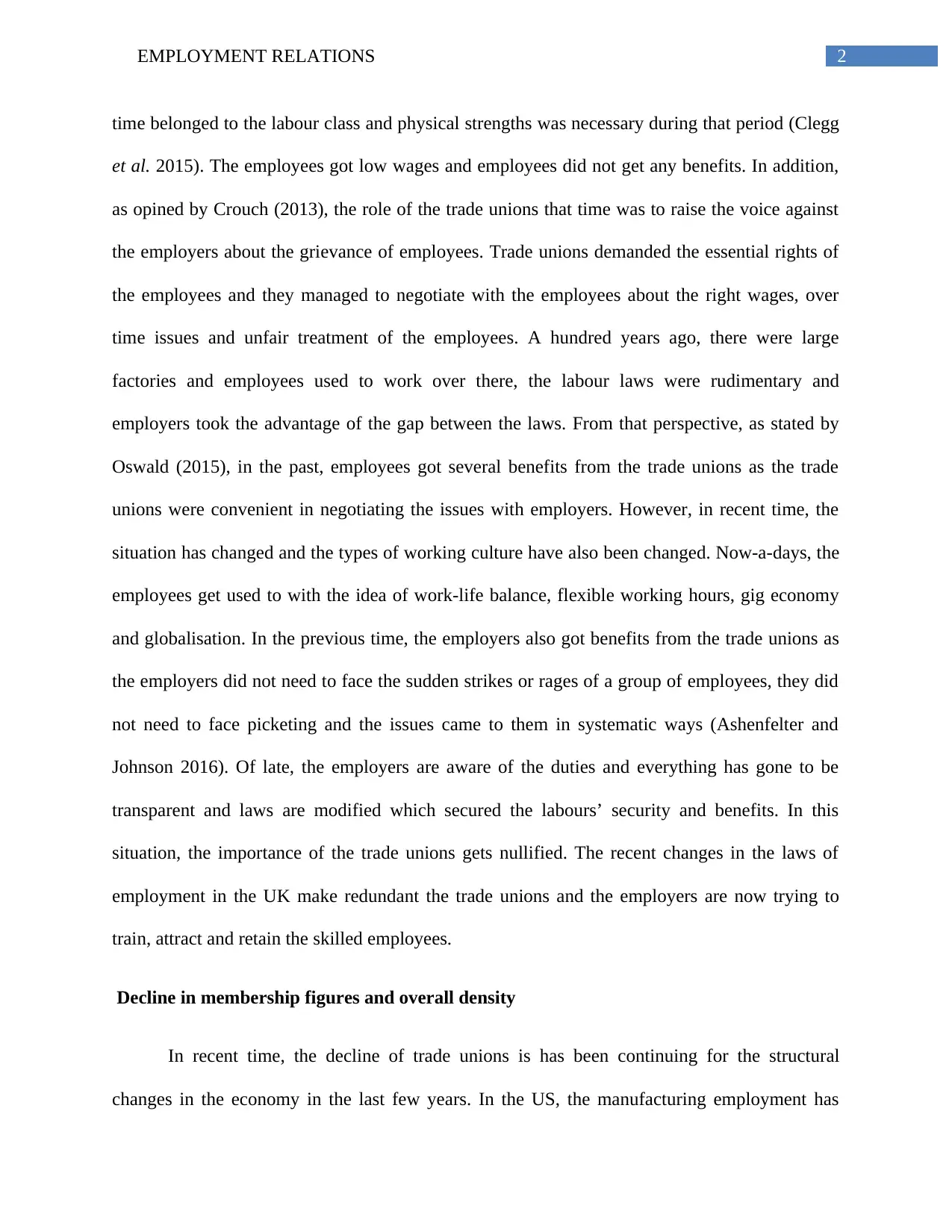
2EMPLOYMENT RELATIONS
time belonged to the labour class and physical strengths was necessary during that period (Clegg
et al. 2015). The employees got low wages and employees did not get any benefits. In addition,
as opined by Crouch (2013), the role of the trade unions that time was to raise the voice against
the employers about the grievance of employees. Trade unions demanded the essential rights of
the employees and they managed to negotiate with the employees about the right wages, over
time issues and unfair treatment of the employees. A hundred years ago, there were large
factories and employees used to work over there, the labour laws were rudimentary and
employers took the advantage of the gap between the laws. From that perspective, as stated by
Oswald (2015), in the past, employees got several benefits from the trade unions as the trade
unions were convenient in negotiating the issues with employers. However, in recent time, the
situation has changed and the types of working culture have also been changed. Now-a-days, the
employees get used to with the idea of work-life balance, flexible working hours, gig economy
and globalisation. In the previous time, the employers also got benefits from the trade unions as
the employers did not need to face the sudden strikes or rages of a group of employees, they did
not need to face picketing and the issues came to them in systematic ways (Ashenfelter and
Johnson 2016). Of late, the employers are aware of the duties and everything has gone to be
transparent and laws are modified which secured the labours’ security and benefits. In this
situation, the importance of the trade unions gets nullified. The recent changes in the laws of
employment in the UK make redundant the trade unions and the employers are now trying to
train, attract and retain the skilled employees.
Decline in membership figures and overall density
In recent time, the decline of trade unions is has been continuing for the structural
changes in the economy in the last few years. In the US, the manufacturing employment has
time belonged to the labour class and physical strengths was necessary during that period (Clegg
et al. 2015). The employees got low wages and employees did not get any benefits. In addition,
as opined by Crouch (2013), the role of the trade unions that time was to raise the voice against
the employers about the grievance of employees. Trade unions demanded the essential rights of
the employees and they managed to negotiate with the employees about the right wages, over
time issues and unfair treatment of the employees. A hundred years ago, there were large
factories and employees used to work over there, the labour laws were rudimentary and
employers took the advantage of the gap between the laws. From that perspective, as stated by
Oswald (2015), in the past, employees got several benefits from the trade unions as the trade
unions were convenient in negotiating the issues with employers. However, in recent time, the
situation has changed and the types of working culture have also been changed. Now-a-days, the
employees get used to with the idea of work-life balance, flexible working hours, gig economy
and globalisation. In the previous time, the employers also got benefits from the trade unions as
the employers did not need to face the sudden strikes or rages of a group of employees, they did
not need to face picketing and the issues came to them in systematic ways (Ashenfelter and
Johnson 2016). Of late, the employers are aware of the duties and everything has gone to be
transparent and laws are modified which secured the labours’ security and benefits. In this
situation, the importance of the trade unions gets nullified. The recent changes in the laws of
employment in the UK make redundant the trade unions and the employers are now trying to
train, attract and retain the skilled employees.
Decline in membership figures and overall density
In recent time, the decline of trade unions is has been continuing for the structural
changes in the economy in the last few years. In the US, the manufacturing employment has
⊘ This is a preview!⊘
Do you want full access?
Subscribe today to unlock all pages.

Trusted by 1+ million students worldwide
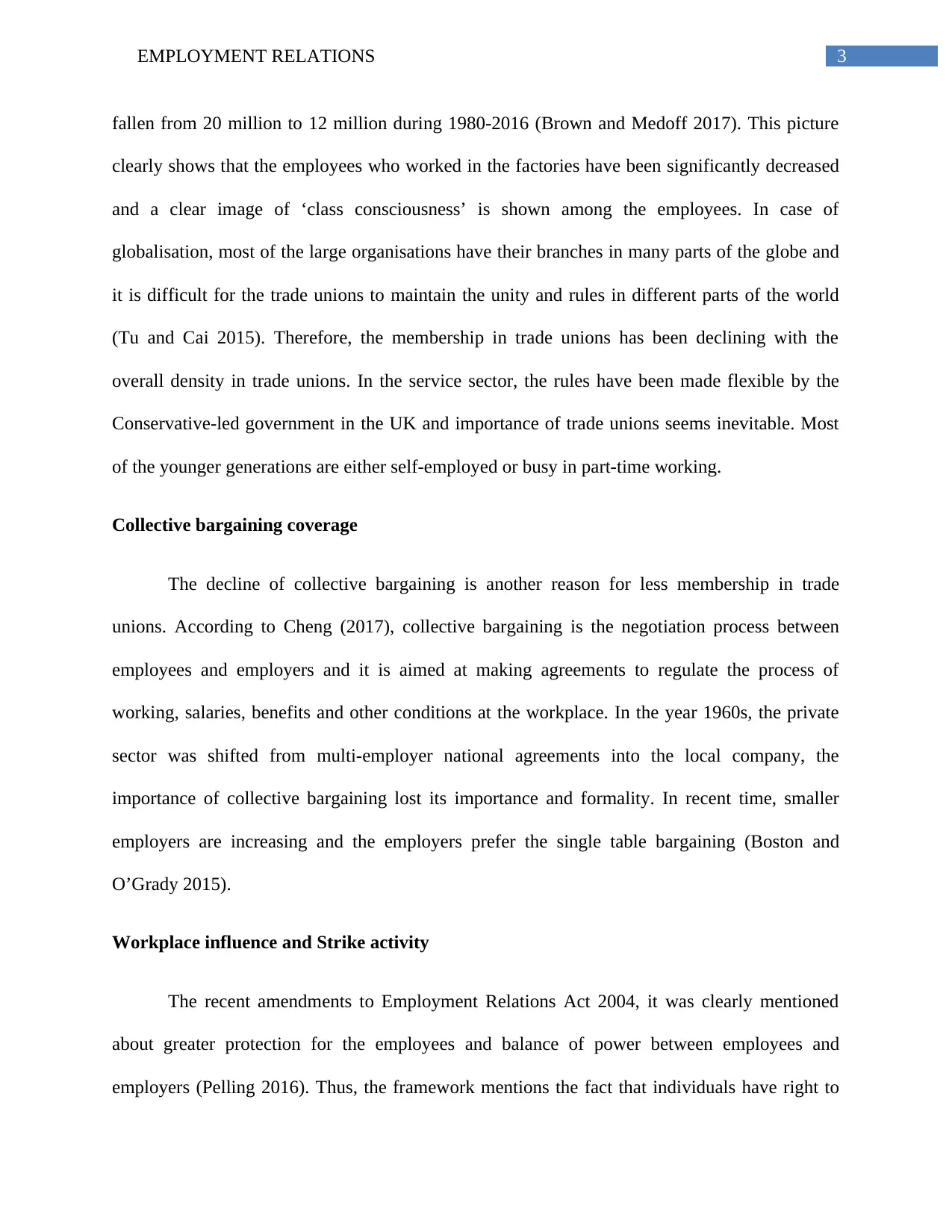
3EMPLOYMENT RELATIONS
fallen from 20 million to 12 million during 1980-2016 (Brown and Medoff 2017). This picture
clearly shows that the employees who worked in the factories have been significantly decreased
and a clear image of ‘class consciousness’ is shown among the employees. In case of
globalisation, most of the large organisations have their branches in many parts of the globe and
it is difficult for the trade unions to maintain the unity and rules in different parts of the world
(Tu and Cai 2015). Therefore, the membership in trade unions has been declining with the
overall density in trade unions. In the service sector, the rules have been made flexible by the
Conservative-led government in the UK and importance of trade unions seems inevitable. Most
of the younger generations are either self-employed or busy in part-time working.
Collective bargaining coverage
The decline of collective bargaining is another reason for less membership in trade
unions. According to Cheng (2017), collective bargaining is the negotiation process between
employees and employers and it is aimed at making agreements to regulate the process of
working, salaries, benefits and other conditions at the workplace. In the year 1960s, the private
sector was shifted from multi-employer national agreements into the local company, the
importance of collective bargaining lost its importance and formality. In recent time, smaller
employers are increasing and the employers prefer the single table bargaining (Boston and
O’Grady 2015).
Workplace influence and Strike activity
The recent amendments to Employment Relations Act 2004, it was clearly mentioned
about greater protection for the employees and balance of power between employees and
employers (Pelling 2016). Thus, the framework mentions the fact that individuals have right to
fallen from 20 million to 12 million during 1980-2016 (Brown and Medoff 2017). This picture
clearly shows that the employees who worked in the factories have been significantly decreased
and a clear image of ‘class consciousness’ is shown among the employees. In case of
globalisation, most of the large organisations have their branches in many parts of the globe and
it is difficult for the trade unions to maintain the unity and rules in different parts of the world
(Tu and Cai 2015). Therefore, the membership in trade unions has been declining with the
overall density in trade unions. In the service sector, the rules have been made flexible by the
Conservative-led government in the UK and importance of trade unions seems inevitable. Most
of the younger generations are either self-employed or busy in part-time working.
Collective bargaining coverage
The decline of collective bargaining is another reason for less membership in trade
unions. According to Cheng (2017), collective bargaining is the negotiation process between
employees and employers and it is aimed at making agreements to regulate the process of
working, salaries, benefits and other conditions at the workplace. In the year 1960s, the private
sector was shifted from multi-employer national agreements into the local company, the
importance of collective bargaining lost its importance and formality. In recent time, smaller
employers are increasing and the employers prefer the single table bargaining (Boston and
O’Grady 2015).
Workplace influence and Strike activity
The recent amendments to Employment Relations Act 2004, it was clearly mentioned
about greater protection for the employees and balance of power between employees and
employers (Pelling 2016). Thus, the framework mentions the fact that individuals have right to
Paraphrase This Document
Need a fresh take? Get an instant paraphrase of this document with our AI Paraphraser
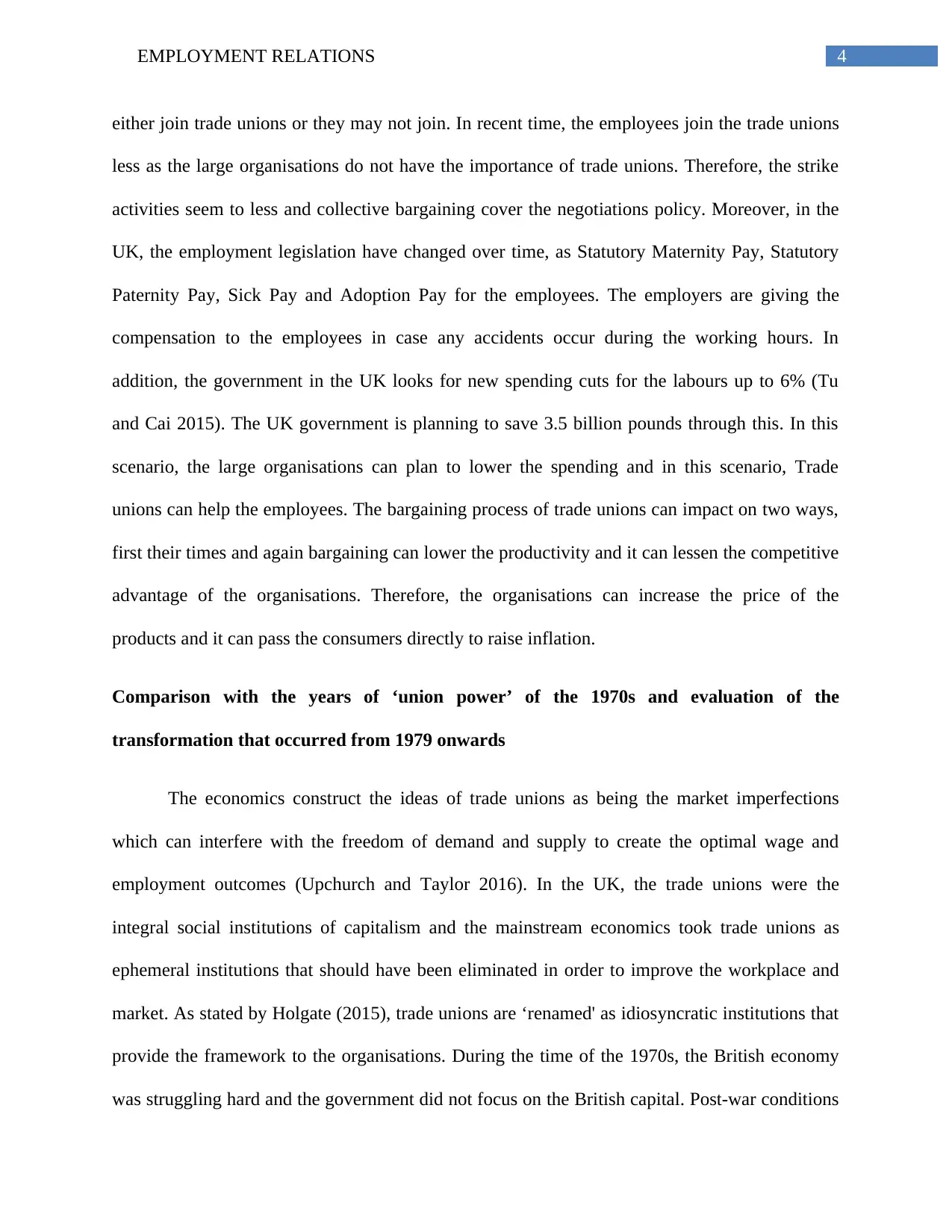
4EMPLOYMENT RELATIONS
either join trade unions or they may not join. In recent time, the employees join the trade unions
less as the large organisations do not have the importance of trade unions. Therefore, the strike
activities seem to less and collective bargaining cover the negotiations policy. Moreover, in the
UK, the employment legislation have changed over time, as Statutory Maternity Pay, Statutory
Paternity Pay, Sick Pay and Adoption Pay for the employees. The employers are giving the
compensation to the employees in case any accidents occur during the working hours. In
addition, the government in the UK looks for new spending cuts for the labours up to 6% (Tu
and Cai 2015). The UK government is planning to save 3.5 billion pounds through this. In this
scenario, the large organisations can plan to lower the spending and in this scenario, Trade
unions can help the employees. The bargaining process of trade unions can impact on two ways,
first their times and again bargaining can lower the productivity and it can lessen the competitive
advantage of the organisations. Therefore, the organisations can increase the price of the
products and it can pass the consumers directly to raise inflation.
Comparison with the years of ‘union power’ of the 1970s and evaluation of the
transformation that occurred from 1979 onwards
The economics construct the ideas of trade unions as being the market imperfections
which can interfere with the freedom of demand and supply to create the optimal wage and
employment outcomes (Upchurch and Taylor 2016). In the UK, the trade unions were the
integral social institutions of capitalism and the mainstream economics took trade unions as
ephemeral institutions that should have been eliminated in order to improve the workplace and
market. As stated by Holgate (2015), trade unions are ‘renamed' as idiosyncratic institutions that
provide the framework to the organisations. During the time of the 1970s, the British economy
was struggling hard and the government did not focus on the British capital. Post-war conditions
either join trade unions or they may not join. In recent time, the employees join the trade unions
less as the large organisations do not have the importance of trade unions. Therefore, the strike
activities seem to less and collective bargaining cover the negotiations policy. Moreover, in the
UK, the employment legislation have changed over time, as Statutory Maternity Pay, Statutory
Paternity Pay, Sick Pay and Adoption Pay for the employees. The employers are giving the
compensation to the employees in case any accidents occur during the working hours. In
addition, the government in the UK looks for new spending cuts for the labours up to 6% (Tu
and Cai 2015). The UK government is planning to save 3.5 billion pounds through this. In this
scenario, the large organisations can plan to lower the spending and in this scenario, Trade
unions can help the employees. The bargaining process of trade unions can impact on two ways,
first their times and again bargaining can lower the productivity and it can lessen the competitive
advantage of the organisations. Therefore, the organisations can increase the price of the
products and it can pass the consumers directly to raise inflation.
Comparison with the years of ‘union power’ of the 1970s and evaluation of the
transformation that occurred from 1979 onwards
The economics construct the ideas of trade unions as being the market imperfections
which can interfere with the freedom of demand and supply to create the optimal wage and
employment outcomes (Upchurch and Taylor 2016). In the UK, the trade unions were the
integral social institutions of capitalism and the mainstream economics took trade unions as
ephemeral institutions that should have been eliminated in order to improve the workplace and
market. As stated by Holgate (2015), trade unions are ‘renamed' as idiosyncratic institutions that
provide the framework to the organisations. During the time of the 1970s, the British economy
was struggling hard and the government did not focus on the British capital. Post-war conditions
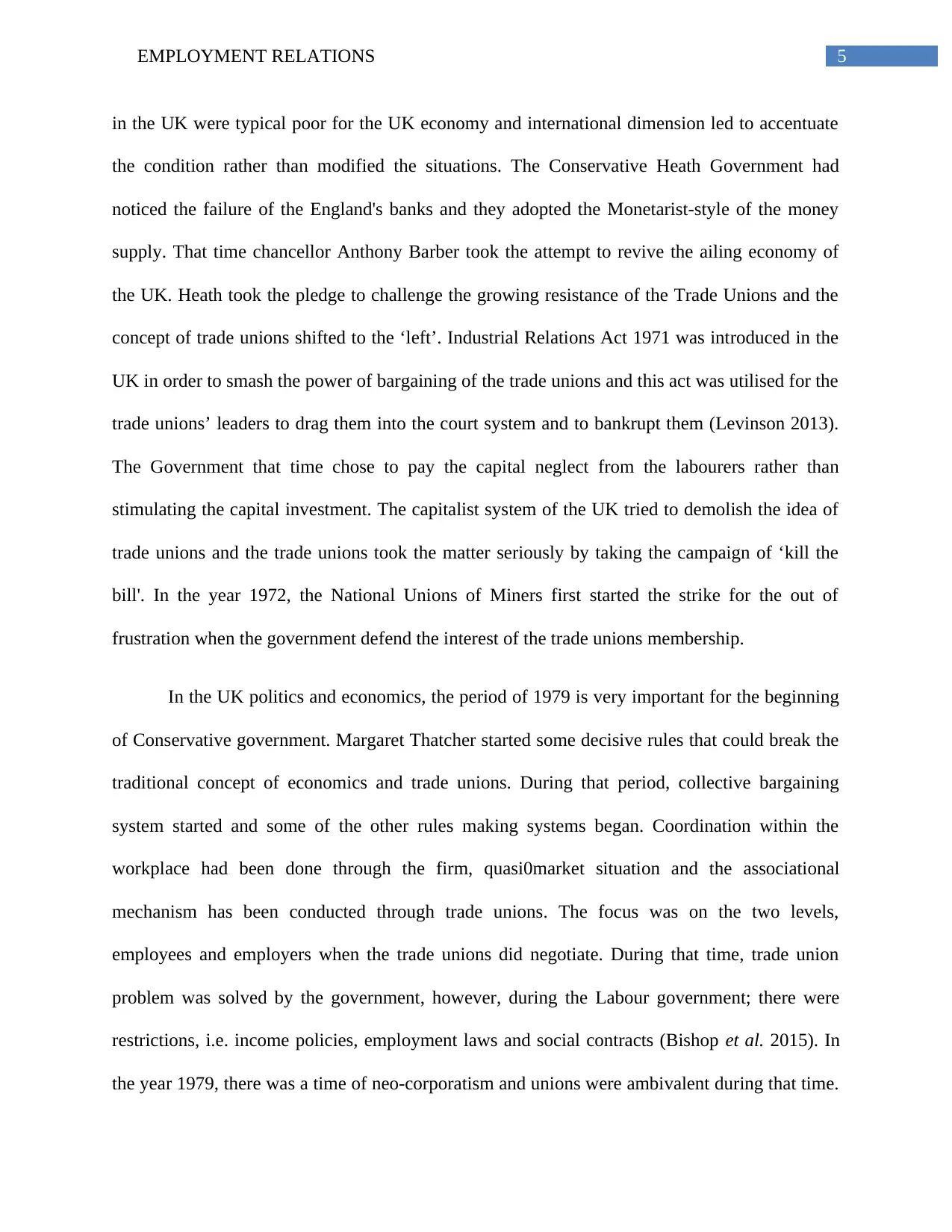
5EMPLOYMENT RELATIONS
in the UK were typical poor for the UK economy and international dimension led to accentuate
the condition rather than modified the situations. The Conservative Heath Government had
noticed the failure of the England's banks and they adopted the Monetarist-style of the money
supply. That time chancellor Anthony Barber took the attempt to revive the ailing economy of
the UK. Heath took the pledge to challenge the growing resistance of the Trade Unions and the
concept of trade unions shifted to the ‘left’. Industrial Relations Act 1971 was introduced in the
UK in order to smash the power of bargaining of the trade unions and this act was utilised for the
trade unions’ leaders to drag them into the court system and to bankrupt them (Levinson 2013).
The Government that time chose to pay the capital neglect from the labourers rather than
stimulating the capital investment. The capitalist system of the UK tried to demolish the idea of
trade unions and the trade unions took the matter seriously by taking the campaign of ‘kill the
bill'. In the year 1972, the National Unions of Miners first started the strike for the out of
frustration when the government defend the interest of the trade unions membership.
In the UK politics and economics, the period of 1979 is very important for the beginning
of Conservative government. Margaret Thatcher started some decisive rules that could break the
traditional concept of economics and trade unions. During that period, collective bargaining
system started and some of the other rules making systems began. Coordination within the
workplace had been done through the firm, quasi0market situation and the associational
mechanism has been conducted through trade unions. The focus was on the two levels,
employees and employers when the trade unions did negotiate. During that time, trade union
problem was solved by the government, however, during the Labour government; there were
restrictions, i.e. income policies, employment laws and social contracts (Bishop et al. 2015). In
the year 1979, there was a time of neo-corporatism and unions were ambivalent during that time.
in the UK were typical poor for the UK economy and international dimension led to accentuate
the condition rather than modified the situations. The Conservative Heath Government had
noticed the failure of the England's banks and they adopted the Monetarist-style of the money
supply. That time chancellor Anthony Barber took the attempt to revive the ailing economy of
the UK. Heath took the pledge to challenge the growing resistance of the Trade Unions and the
concept of trade unions shifted to the ‘left’. Industrial Relations Act 1971 was introduced in the
UK in order to smash the power of bargaining of the trade unions and this act was utilised for the
trade unions’ leaders to drag them into the court system and to bankrupt them (Levinson 2013).
The Government that time chose to pay the capital neglect from the labourers rather than
stimulating the capital investment. The capitalist system of the UK tried to demolish the idea of
trade unions and the trade unions took the matter seriously by taking the campaign of ‘kill the
bill'. In the year 1972, the National Unions of Miners first started the strike for the out of
frustration when the government defend the interest of the trade unions membership.
In the UK politics and economics, the period of 1979 is very important for the beginning
of Conservative government. Margaret Thatcher started some decisive rules that could break the
traditional concept of economics and trade unions. During that period, collective bargaining
system started and some of the other rules making systems began. Coordination within the
workplace had been done through the firm, quasi0market situation and the associational
mechanism has been conducted through trade unions. The focus was on the two levels,
employees and employers when the trade unions did negotiate. During that time, trade union
problem was solved by the government, however, during the Labour government; there were
restrictions, i.e. income policies, employment laws and social contracts (Bishop et al. 2015). In
the year 1979, there was a time of neo-corporatism and unions were ambivalent during that time.
⊘ This is a preview!⊘
Do you want full access?
Subscribe today to unlock all pages.

Trusted by 1+ million students worldwide
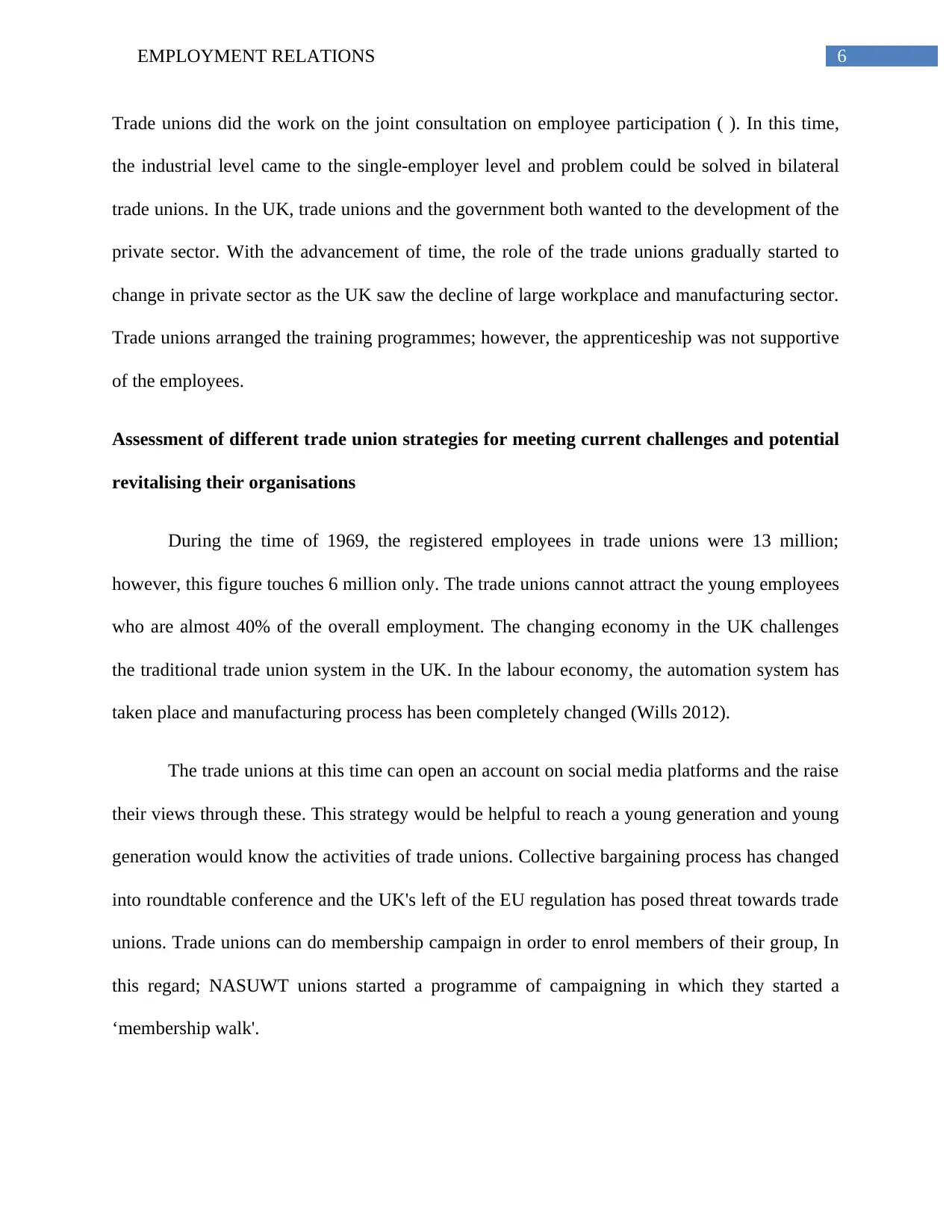
6EMPLOYMENT RELATIONS
Trade unions did the work on the joint consultation on employee participation ( ). In this time,
the industrial level came to the single-employer level and problem could be solved in bilateral
trade unions. In the UK, trade unions and the government both wanted to the development of the
private sector. With the advancement of time, the role of the trade unions gradually started to
change in private sector as the UK saw the decline of large workplace and manufacturing sector.
Trade unions arranged the training programmes; however, the apprenticeship was not supportive
of the employees.
Assessment of different trade union strategies for meeting current challenges and potential
revitalising their organisations
During the time of 1969, the registered employees in trade unions were 13 million;
however, this figure touches 6 million only. The trade unions cannot attract the young employees
who are almost 40% of the overall employment. The changing economy in the UK challenges
the traditional trade union system in the UK. In the labour economy, the automation system has
taken place and manufacturing process has been completely changed (Wills 2012).
The trade unions at this time can open an account on social media platforms and the raise
their views through these. This strategy would be helpful to reach a young generation and young
generation would know the activities of trade unions. Collective bargaining process has changed
into roundtable conference and the UK's left of the EU regulation has posed threat towards trade
unions. Trade unions can do membership campaign in order to enrol members of their group, In
this regard; NASUWT unions started a programme of campaigning in which they started a
‘membership walk'.
Trade unions did the work on the joint consultation on employee participation ( ). In this time,
the industrial level came to the single-employer level and problem could be solved in bilateral
trade unions. In the UK, trade unions and the government both wanted to the development of the
private sector. With the advancement of time, the role of the trade unions gradually started to
change in private sector as the UK saw the decline of large workplace and manufacturing sector.
Trade unions arranged the training programmes; however, the apprenticeship was not supportive
of the employees.
Assessment of different trade union strategies for meeting current challenges and potential
revitalising their organisations
During the time of 1969, the registered employees in trade unions were 13 million;
however, this figure touches 6 million only. The trade unions cannot attract the young employees
who are almost 40% of the overall employment. The changing economy in the UK challenges
the traditional trade union system in the UK. In the labour economy, the automation system has
taken place and manufacturing process has been completely changed (Wills 2012).
The trade unions at this time can open an account on social media platforms and the raise
their views through these. This strategy would be helpful to reach a young generation and young
generation would know the activities of trade unions. Collective bargaining process has changed
into roundtable conference and the UK's left of the EU regulation has posed threat towards trade
unions. Trade unions can do membership campaign in order to enrol members of their group, In
this regard; NASUWT unions started a programme of campaigning in which they started a
‘membership walk'.
Paraphrase This Document
Need a fresh take? Get an instant paraphrase of this document with our AI Paraphraser
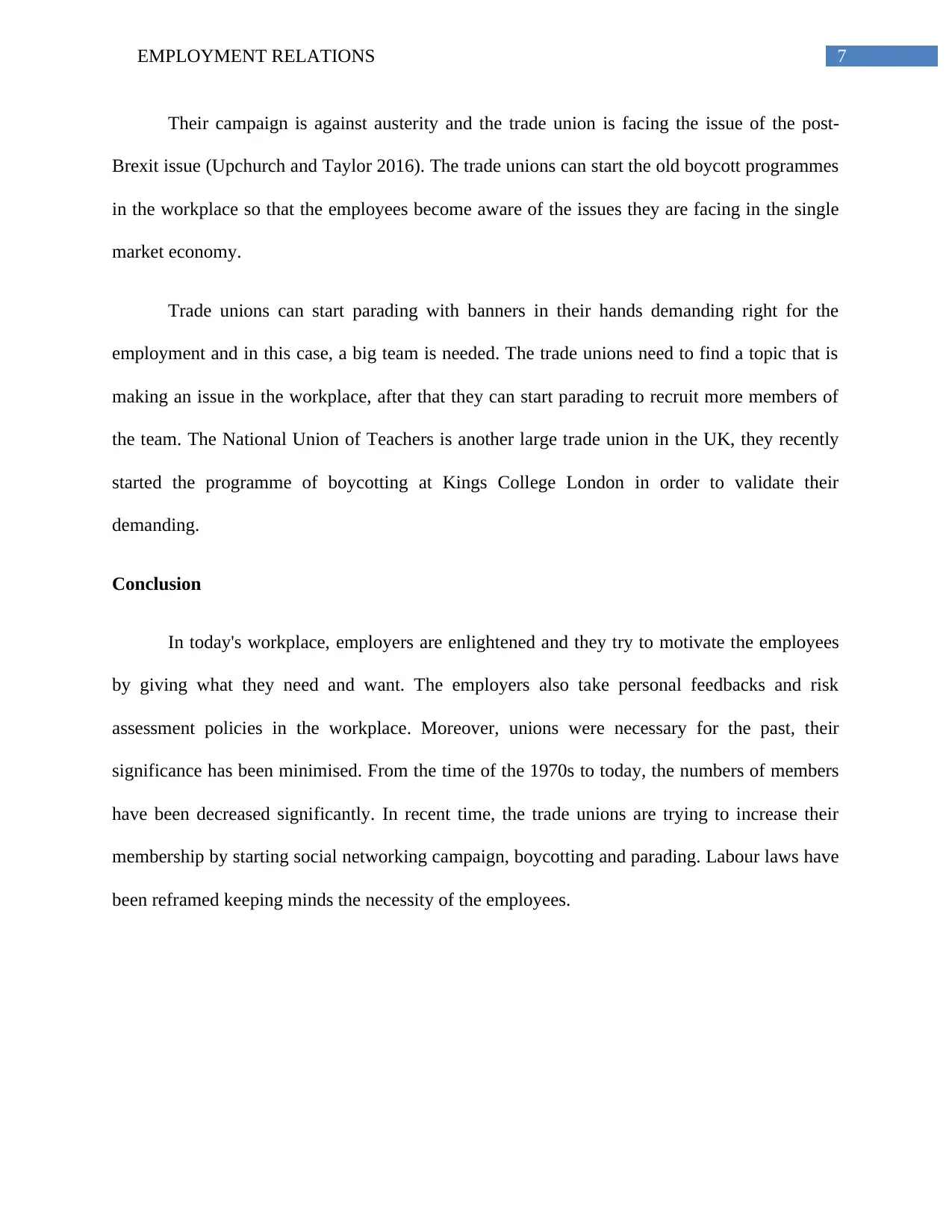
7EMPLOYMENT RELATIONS
Their campaign is against austerity and the trade union is facing the issue of the post-
Brexit issue (Upchurch and Taylor 2016). The trade unions can start the old boycott programmes
in the workplace so that the employees become aware of the issues they are facing in the single
market economy.
Trade unions can start parading with banners in their hands demanding right for the
employment and in this case, a big team is needed. The trade unions need to find a topic that is
making an issue in the workplace, after that they can start parading to recruit more members of
the team. The National Union of Teachers is another large trade union in the UK, they recently
started the programme of boycotting at Kings College London in order to validate their
demanding.
Conclusion
In today's workplace, employers are enlightened and they try to motivate the employees
by giving what they need and want. The employers also take personal feedbacks and risk
assessment policies in the workplace. Moreover, unions were necessary for the past, their
significance has been minimised. From the time of the 1970s to today, the numbers of members
have been decreased significantly. In recent time, the trade unions are trying to increase their
membership by starting social networking campaign, boycotting and parading. Labour laws have
been reframed keeping minds the necessity of the employees.
Their campaign is against austerity and the trade union is facing the issue of the post-
Brexit issue (Upchurch and Taylor 2016). The trade unions can start the old boycott programmes
in the workplace so that the employees become aware of the issues they are facing in the single
market economy.
Trade unions can start parading with banners in their hands demanding right for the
employment and in this case, a big team is needed. The trade unions need to find a topic that is
making an issue in the workplace, after that they can start parading to recruit more members of
the team. The National Union of Teachers is another large trade union in the UK, they recently
started the programme of boycotting at Kings College London in order to validate their
demanding.
Conclusion
In today's workplace, employers are enlightened and they try to motivate the employees
by giving what they need and want. The employers also take personal feedbacks and risk
assessment policies in the workplace. Moreover, unions were necessary for the past, their
significance has been minimised. From the time of the 1970s to today, the numbers of members
have been decreased significantly. In recent time, the trade unions are trying to increase their
membership by starting social networking campaign, boycotting and parading. Labour laws have
been reframed keeping minds the necessity of the employees.
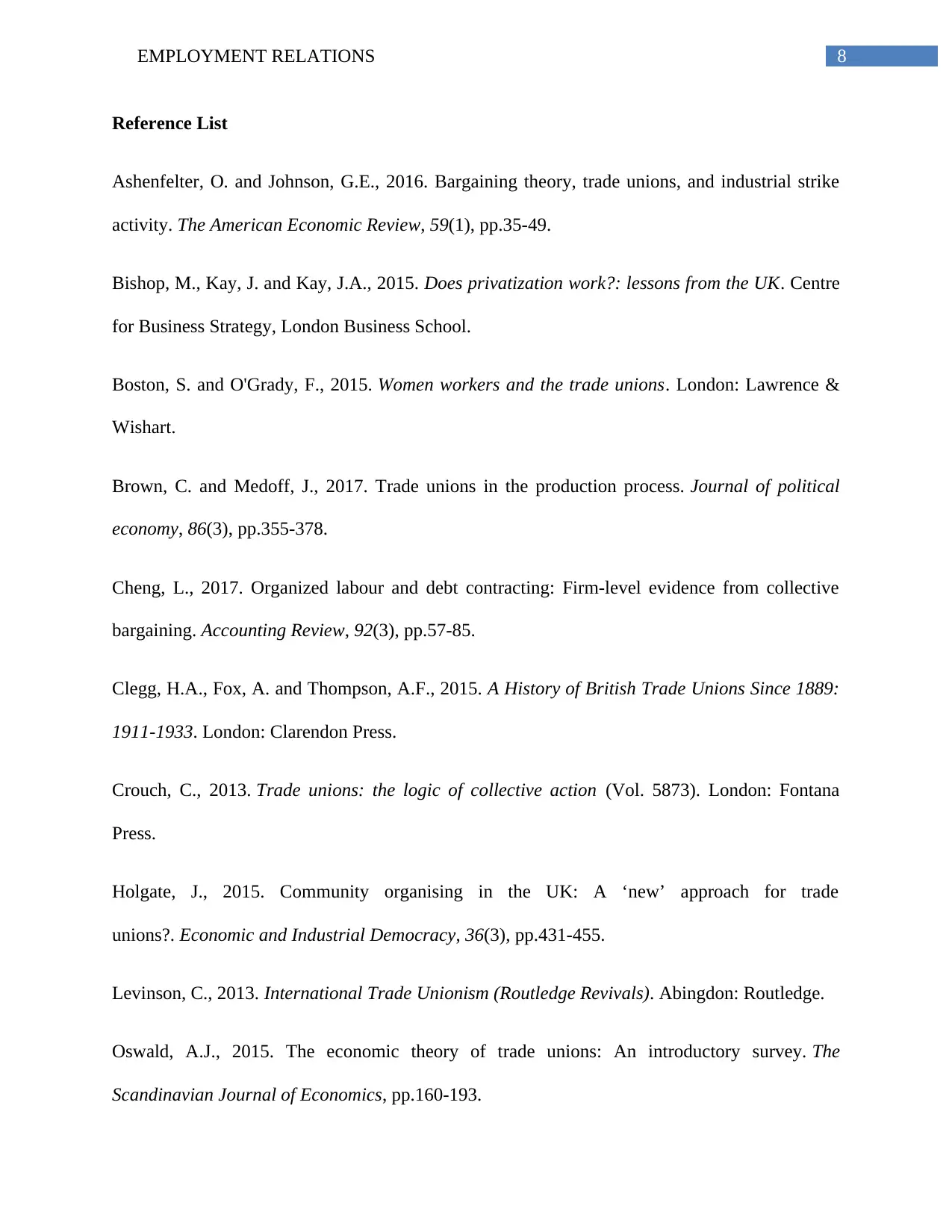
8EMPLOYMENT RELATIONS
Reference List
Ashenfelter, O. and Johnson, G.E., 2016. Bargaining theory, trade unions, and industrial strike
activity. The American Economic Review, 59(1), pp.35-49.
Bishop, M., Kay, J. and Kay, J.A., 2015. Does privatization work?: lessons from the UK. Centre
for Business Strategy, London Business School.
Boston, S. and O'Grady, F., 2015. Women workers and the trade unions. London: Lawrence &
Wishart.
Brown, C. and Medoff, J., 2017. Trade unions in the production process. Journal of political
economy, 86(3), pp.355-378.
Cheng, L., 2017. Organized labour and debt contracting: Firm-level evidence from collective
bargaining. Accounting Review, 92(3), pp.57-85.
Clegg, H.A., Fox, A. and Thompson, A.F., 2015. A History of British Trade Unions Since 1889:
1911-1933. London: Clarendon Press.
Crouch, C., 2013. Trade unions: the logic of collective action (Vol. 5873). London: Fontana
Press.
Holgate, J., 2015. Community organising in the UK: A ‘new’ approach for trade
unions?. Economic and Industrial Democracy, 36(3), pp.431-455.
Levinson, C., 2013. International Trade Unionism (Routledge Revivals). Abingdon: Routledge.
Oswald, A.J., 2015. The economic theory of trade unions: An introductory survey. The
Scandinavian Journal of Economics, pp.160-193.
Reference List
Ashenfelter, O. and Johnson, G.E., 2016. Bargaining theory, trade unions, and industrial strike
activity. The American Economic Review, 59(1), pp.35-49.
Bishop, M., Kay, J. and Kay, J.A., 2015. Does privatization work?: lessons from the UK. Centre
for Business Strategy, London Business School.
Boston, S. and O'Grady, F., 2015. Women workers and the trade unions. London: Lawrence &
Wishart.
Brown, C. and Medoff, J., 2017. Trade unions in the production process. Journal of political
economy, 86(3), pp.355-378.
Cheng, L., 2017. Organized labour and debt contracting: Firm-level evidence from collective
bargaining. Accounting Review, 92(3), pp.57-85.
Clegg, H.A., Fox, A. and Thompson, A.F., 2015. A History of British Trade Unions Since 1889:
1911-1933. London: Clarendon Press.
Crouch, C., 2013. Trade unions: the logic of collective action (Vol. 5873). London: Fontana
Press.
Holgate, J., 2015. Community organising in the UK: A ‘new’ approach for trade
unions?. Economic and Industrial Democracy, 36(3), pp.431-455.
Levinson, C., 2013. International Trade Unionism (Routledge Revivals). Abingdon: Routledge.
Oswald, A.J., 2015. The economic theory of trade unions: An introductory survey. The
Scandinavian Journal of Economics, pp.160-193.
⊘ This is a preview!⊘
Do you want full access?
Subscribe today to unlock all pages.

Trusted by 1+ million students worldwide
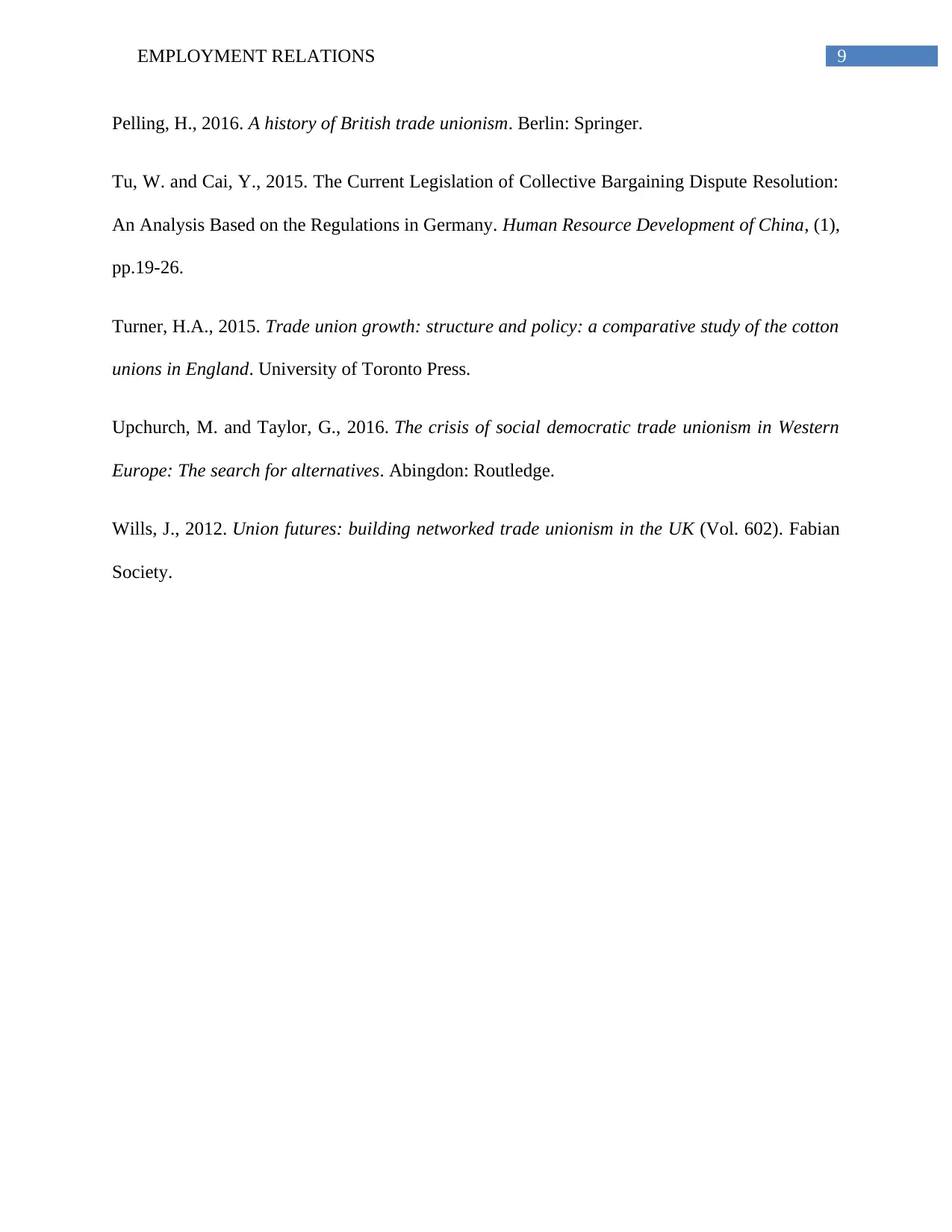
9EMPLOYMENT RELATIONS
Pelling, H., 2016. A history of British trade unionism. Berlin: Springer.
Tu, W. and Cai, Y., 2015. The Current Legislation of Collective Bargaining Dispute Resolution:
An Analysis Based on the Regulations in Germany. Human Resource Development of China, (1),
pp.19-26.
Turner, H.A., 2015. Trade union growth: structure and policy: a comparative study of the cotton
unions in England. University of Toronto Press.
Upchurch, M. and Taylor, G., 2016. The crisis of social democratic trade unionism in Western
Europe: The search for alternatives. Abingdon: Routledge.
Wills, J., 2012. Union futures: building networked trade unionism in the UK (Vol. 602). Fabian
Society.
Pelling, H., 2016. A history of British trade unionism. Berlin: Springer.
Tu, W. and Cai, Y., 2015. The Current Legislation of Collective Bargaining Dispute Resolution:
An Analysis Based on the Regulations in Germany. Human Resource Development of China, (1),
pp.19-26.
Turner, H.A., 2015. Trade union growth: structure and policy: a comparative study of the cotton
unions in England. University of Toronto Press.
Upchurch, M. and Taylor, G., 2016. The crisis of social democratic trade unionism in Western
Europe: The search for alternatives. Abingdon: Routledge.
Wills, J., 2012. Union futures: building networked trade unionism in the UK (Vol. 602). Fabian
Society.
1 out of 10
Related Documents
Your All-in-One AI-Powered Toolkit for Academic Success.
+13062052269
info@desklib.com
Available 24*7 on WhatsApp / Email
![[object Object]](/_next/static/media/star-bottom.7253800d.svg)
Unlock your academic potential
Copyright © 2020–2025 A2Z Services. All Rights Reserved. Developed and managed by ZUCOL.



